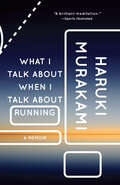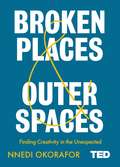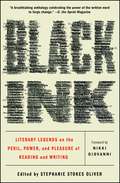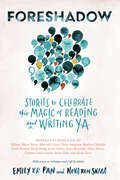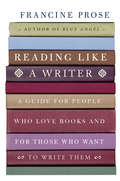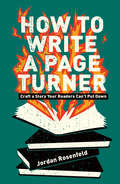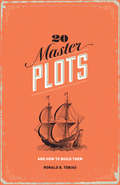Special Collections
NaNoWriMo
Description: Are you participating in National Novel Writing Month (NaNoWriMo)? If so, get started with some craft books on writing and revising! #writing #writer #nanowrimo #nationalnovelwritingmonth
- Table View
- List View
What I Talk About When I Talk About Running
by Haruki MurakamiAn intimate look at writing, running, and the incredible way they intersect, What I Talk About When I Talk About Running is an illuminating glimpse into the solitary passions of one of our greatest artists.While training for the New York City Marathon, Haruki Murakami decided to keep a journal of his progress. The result is a memoir about his intertwined obsessions with running and writing, full of vivid recollections and insights, including the eureka moment when he decided to become a writer. By turns funny and sobering, playful and philosophical, here is a rich and revelatory work that elevates the human need for motion to an art form.
Broken Places & Outer Spaces
by Nnedi OkoraforNnedi Okorafor was never supposed to be paralyzed. A college track star and budding entomologist, Nnedi’s lifelong battle with scoliosis was just a bump in her plan - something a simple surgery would easily correct. But when Nnedi wakes from the surgery to find she can’t move her legs, her entire sense of who she is begins to waver. Confined to a hospital bed for months, unusual things begin to happen. Psychedelic bugs crawl her hospital walls; strange dreams visit her nightly. She begins to feel as if she’s turning into a cyborg. Unsure if she’ll ever walk again, Nnedi begins to put these experiences into writing, conjuring up strange, fantastical stories. What Nnedi discovers during her confinement would prove to be the key to her life as a successful science fiction writer: In science fiction, when something breaks, something greater often emerges from the cracks. While she may be bedridden, instead of stopping her journey Nnedi’s paralysis opens up new windows in her mind, kindles her creativity and ultimately leads her to become more alive than she ever could have imagined. Nnedi takes the reader on a journey from her hospital bed deep into her memories, from her painful first experiences with racism as a child in Chicago to her powerful visits to her parents’ hometown in Nigeria, where she got her first inkling that science fiction has roots beyond the West. This was not the Africa that Nnedi knew from Western literature - an Africa that she always read was a place left behind. The role of technology in Nigeria opened her eyes to future-looking Africa: cable TV and cell phones in the village, 419 scammers occupying the cybercafés, the small generator connected to her cousin’s desktop computer, everyone quickly adapting to portable tech devices due to unreliable power sources. Nnedi could see that Africa was far from broken, as she’d been taught, and her experience there planted the early seeds of sci-fi - a genre that speculates about technologies, societies, and social issues - from an entirely new lens. In Broken Places & Outer Spaces, Nnedi uses her own experience as a jumping off point to follow the phenomenon of creativity born from hardship. From Frida Kahlo to Mary Shelly, she examines great artists and writers who have pushed through their limitations, using hardship to fuel their work. Through these compelling stories and her own, Nnedi reveals a universal truth: What we perceive as limitations have the potential to become our greatest strengths - far greater than when we were unbroken.
Black Ink
by Stephanie Stokes OliverSpanning over 250 years of history, Black Ink traces black literature in America from Frederick Douglass to Ta-Nehisi Coates in this &“breathtaking anthology celebrating the power of the written word to forge change&” (O, The Oprah Magazine).Throughout American history black people are the only group of people to have been forbidden by law to learn to read. This expansive collection seeks to shed light on that injustice, putting some of America&’s most cherished voices in a conversation in one magnificent volume that presents reading as an act of resistance. Organized into three sections—the Peril, the Power, and the Pleasure—and featuring a vast array of contributors both classic and contemporary, Black Ink presents the brilliant diversity of black thought in America while solidifying the importance of these writers within the greater context of the American literary tradition. &“This electric and electrifying collection of voices serves to open a much-needed window onto the freedom struggle of black literature. It&’s a marvel, and a genuine gift for readers everywhere&” (Wil Haygood, author of The Butler: A Witness to History). Contributors include: Frederick Douglass, Solomon Northup, Booker T. Washington, W.E.B. Du Bois, Zora Neale Hurston, Langston Hughes, James Baldwin, Malcolm X, Maya Angelou, Martin Luther King, Jr., Toni Morrison, Walter Dean Myers, Stokely Carmichael [Kwame Ture], Alice Walker, Jamaica Kincaid, Henry Louis Gates, Jr., Terry McMillan, Junot Diaz, Edwidge Danticat, Colson Whitehead, Marlon James, Roxane Gay, Ta-Nehisi Coates, Chimamanda Ngozi Adichie, and Colson Whitehead. The anthology features a bonus in-depth interview with President Barack Obama.
Foreshadow
by Nova Ren Suma and Emily X.R. PanThirteen Short Stories from Bold New YA Voices & Writing Advice from YA Icons Created by New York Times bestselling authors Emily X. R. Pan and Nova Ren Suma, Foreshadow is so much more than a short story collection. A trove of unforgettable fiction makes up the beating heart of this book, and the accompanying essays offer an ode to young adult literature, as well as practical advice to writers. Featured in print for the first time, the thirteen stories anthologized here were originally released via the buzzed-about online platform Foreshadow. Ranging from contemporary romance to mind-bending fantasy, the Foreshadow stories showcase underrepresented voices and highlight the beauty and power of YA fiction. Each piece is selected and introduced by a YA luminary, among them Gayle Forman, Laurie Halse Anderson, Jason Reynolds, and Sabaa Tahir. What makes these memorable stories tick? What sparked them? How do authors build a world or refine a voice or weave in that deliciously creepy atmosphere to bring their writing to the next level? Addressing these questions and many more are essays and discussions on craft and process by Nova Ren Suma and Emily X. R. Pan. This unique compilation reveals and celebrates the magic of reading and writing for young adults.
Reading Like a Writer
by Francine ProseA distinguished novelist and critic inspires readers and writers with this inside look at how the professionals read—and write Long before there were creative writing workshops and degrees, how did aspiring writers learn to write? By reading the work of their predecessors and contemporaries, says Francine Prose. As she takes us on a guided tour of the tools and the tricks of the masters—Dostoyevsky, Flaubert, Kafka, Austen, Dickens, Woolf, Chekhov—Prose discovers why these writers endure. She takes pleasure in the signature elements of such outsatanding writers as Philip Roth, Isaac Babel, John Le Carré, James Joyce, and Katherine Mansfield. Throughout, she cautions readers to slow down and pay attention to words, the raw material out of which literature is crafted. Written with passion, humor, and wisdom, Reading Like a Writer will inspire readers to return to literature with a fresh eye and an eager heart.
How To Write A Page-Turner
by Jordan RosenfeldInfuse Your Fiction with the Powerful Tug of Tension! Tension is the heart of conflict, the backbone of uncertainty, the hallmark of danger. It keeps readers guessing and characters on their toes. When you've got tension in place, stories leave readers breathless and wanting more. When it's missing, scenes feel inconsequential, plots drag, and characters meander. Learning the craft of writing can sometimes feel like a paint by numbers approach--connect compelling character A to plot event B. To avoid writing that's formulaic, predictable, and slow, How to Write a Page Turner will help you sew the threads of tension tight for an unforgettable story. You'll learn how to:Recognize the essential tension elements of danger, conflict, uncertainty, and withholding, and add them to your fictionCreate levels of tension in your characters through flaws, dialogue, power struggles, and moreBuild tension at energetic markers throughout the plotUse intimate imagery, strong sentences, and well-chosen words to build tension in expositionWhile this book walks you through the key areas that need tension building, from character to plot, it also delves deeper, analyzing exceptional examples from contemporary fiction's most gripping page-turners. So as you dive into the inner conflicts of a character's deepest psyche, to the mechanics of how you reveal information to the reader, you'll also discover how to craft a story your readers can't put down!
20 Master Plots
by Ronald B TobiasGive your story a solid foundation-a plot that engages readers from start to finish! The best stories linger in the hearts and minds of readers for decades. These tales gain their power through plots that connect with the audience on both an emotional and intellectual level. Inside Ronald B. Tobias details these 20 time-tested plots. Each is discussed and analyzed, illustrating how a successful plot integrates all the elements of a story. Tobias then shows you how to use these plots effectively in your own work. Tobias then goes to the next level, showing you how to choose and develop plot in fiction. He shows you how to craft plot for any subject matter, so that you develop your work evenly and effectively. As a result, your fiction will be more cohesive and convincing, making your story unforgettable for readers everywhere. "Plot isn't an accessory that conveniently organizes your material according to some ritualistic magic. You don't just plug in plot like a household appliance and expect it to do its job. Plot is organic. It takes hold of the writer and the work from the beginning." -Ronald Tobias
